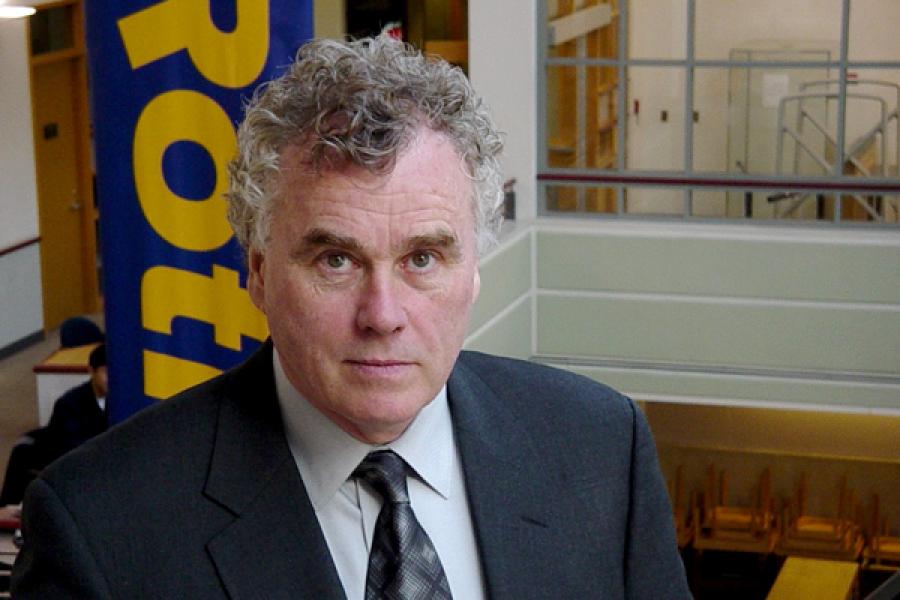
The greatest imbalance of all
The world's remarkable economic gains have eradicated poverty but within nations, problems of inequality are worsening. We need better public policy that allows everyone to play a meaningful and properly rewarded role in society
When the World Economic Forum recently asked 500 of its clan to identify ‘the world’s greatest threat’, the overwhelming response was not global warming. Nor was it geopolitical tensions or nukes in rogue states. The most common response, by a longshot, was extreme income inequality.
Chances are, as you read this, you count yourself among the wealthy, healthy, well-educated and comfortable. Well done. From your perch on the sunny side of the inequality spectrum, you may be blasé about its effects. But be careful: when it comes to inequality, perspective is shaped by circumstances, and your perspective dictates what you might choose to do about this great threat to the world.
Two pairs of distinctions will help me lay out my argument:
Distinction #1: Income inequality vs. wealth inequality.
Distinction #2: The global perspective vs. the local country-level view.
Income inequality is relatively straightforward: take everyone’s income, rank them from low to high and apply a little algebra to come up with an index of inequality. Such measures—observed within nations—indicate that income inequality is increasing almost everywhere; the U.S. and China jump out as particularly striking cases.
When we do the sums, the results also reveal that a lucky few—the top 1, 2 or 5 per cent—have captured much of the swell of economic growth over the past 25 years. The middle part of the distribution—the ‘middle class’—has not seen its share rise at all. While there are explanations for this, none offer much comfort; ‘the rich and the rest’, as it were.
Just as income differs from wealth, income inequality differs from wealth inequality. The pairs are related, however, in the sense that income accumulates into wealth. The who’s who of global wealth suggests that fully half the world’s wealth, US$110 trillion, is held by a mere one per cent of the world’s population.
Concentration of economic resources in the hands of a few presents a threat to inclusive political and economic systems. Larry Summers, former U.S. Secretary of the Treasury, puts it in institutional terms: “When the rich get richer, they get more powerful, and that puts them in the position to lobby for policies that make them richer still.” Summers echoes the British political theorist, Harold Laski: “A state divided into a small number of rich and a large number of poor will always develop a government manipulated by the rich to protect the amenities represented by their property.”
Distinction #2 contrasts the planet and our constituent nations. If you were on the moon and called earth to ask, “Is economic inequality worsening down there?”, you would get an irksome answer: “Yes and no.” Income and wealth inequality are deteriorating within many nations; so there is the ‘yes’, where things are getting worse. However, the global perspective suggests something quite different: global inequality is declining. Things are improving. Why? Well, previously impoverished nations—especially huge ones like China, India and Brazil—have generated spectacular economic growth of late. Seen from the moon, as vast numbers of the earth’s poor become better off, global inequality declines. China alone lifted more than half a billion people out of poverty within a generation.
So, good news for the world on the inequality front. But the welcome movement towards equality from a global perspective casts even greater light on the deteriorating situation within many nations, which has implications that are socially divisive and politically corrosive. Indeed, inequality can tear a nation apart. We must look to the root causes of increasing within-nation economic inequality in the modern era, the social and political consequences that ensue, and the prospect of righting the wrongs – or, apropos the theme of this issue, restoring balance.
At the level of individual nations, the causes of increasing inequality are not the same across the board. Increasing inequality in emerging nations—for instance, China—is fundamentally different from, say, an advanced industrial nation such as the U.S. These two large countries are structurally different, and highlighting these differences is useful for understanding the economic forces—and the politics and the institutional development—that offer promise for a just and more equitable within-nation distribution of income.
China provides a particular stereotype of the relation between economic development and inequality. Sixty years ago, Simon Kuznets demonstrated the connection for a large set of countries. With the famous Kuznets Curve, inequality gets worse before it gets better, and then reverses toward greater equality. The explanation is straightforward: low income equality is associated with a primarily agricultural economy. All those peasants are equally poor. With industrialization and urbanization, inequality emerges as a reflection of higher worker productivity in the new setting; then, at some critical point, inequality begins to diminish over time. Eventually, the growth path becomes virtuous: greater income is more evenly distributed. Indeed, the rise and fall of inequality is now a stylized fact of development; but what is that critical inflection point, and how can it be reached sooner rather than later?
Sir Arthur Lewis, the Nobel Prize-winning economist, supported Kuznets with the view that "development must be inegalitarian because it does not start in every part of the economy at the same time". Present-day China links two positive forces that Lewis had in mind: rural-urban migration and the return to investment in education and technical skills.
As an underdeveloped country, China had relatively few educated people and a small minority (20 per cent) of the population living in cities where labour productivity was about twice that in the countryside. In those dark days, an individual’s return to education was not reflected in income. Construction workers and college professors, factory workers and farmers had similar incomes. Now, though, economic reform has created a labour market in which people can successfully search for higher pay, with the result that incomes of educated and technically-skilled workers have gone up dramatically. The wage returns from an additional year of schooling are substantial.
Income inequality, then, mirrors the distribution of education and valued skills. With reasonable access to education, over time a greater share of the population becomes educated and that ultimately tends to reduce inequality. So, education and skills-training are key. Alas, to recognize education as key reveals that unequal access to education works to entrench income inequality. I will return to this critical point.
The productivity and wage gap between cities and the countryside drives rural-urban migration. The initial shift from low-productivity agriculture to high-productivity industrial employment is disequalizing. Beyond an inflection point, which history suggests is about 50 per cent urban, further rural-to-urban migration is equalizing. This pattern is evident in the history of the U.S., with inequality rising during the rapid industrialization period from 1870–1920, and then declining thereafter. In China, the forces that underpin its rapid commercial growth have predictably led to higher inequality.
The classical explanation of inequality—urban/rural, industry/agriculture, more or less skilled—calls for a closer look at China vis-à-vis the U.S.. Not China and the U.S. today, but rather 125 years ago, when America was in its Gilded Age. The parallels are striking: back then, the U.S. was recovering from a civil war and investing heavily in infrastructure such as ports, railways and electrification. Business was booming, banking was precarious. Rural-to-urban migration fed labour to industry. The rich—typified by titans and robber barons—were becoming ever more powerful, both commercially and politically. A social safety net had not yet evolved, although there were movements afoot. Much like China today.
Today, of course, the U.S. and China are ensnarled in the social distress of economic inequality that is getting worse in both places. But the proximate causes are not the same, and they need to be sorted out. Perhaps there is no natural path to equality, or if there is, then it may involve more than simply increasing GDP.
Today’s most talked-about book on Economics is written by a French neo-Marxist, Thomas Piketty. The title itself, Capital in the 21st Century, is a provocative play on Marx’s classic, Capital. Piketty rebuts the notion that societies evolve to greater equality as their economies mature. On the contrary, inequality rises when the rate of return on capital exceeds the growth rate of the economy, which is likely to be the case both in economies in transition, like China, and in post-industrial societies, like the U.S. Since those with access to capital accumulate wealth faster than those who earn wages, capitalism ends up entrenching inequality. Marx redux, and tough to refute.
In Piketty’s view, inequality—by most measures worse today than any time in the past 70 years—is driven by a combination of technological change and the effects of globalization. Production of both goods and services has become more technologically sophisticated and more capital-intensive. Robots and smart machines of various sorts produce goods and services with proportionately less manpower. Labour with skill to operate the controls, or the smarts to know how to build and maintain the machines, command high wages that are justified by high productivity. On the downside, fewer workers are required.
Inequality and evolving technology are linked to globalization in two ways. Technology-intensive goods and services that can be exported score big gains for those involved, and the skilled and the smart benefit accordingly. Alas the less skilled, out of step, see their jobs replaced by workers in low-wage countries via imports. This fits Piketty’s thesis without even mentioning Marx. There are countless examples—in manufacturing, construction, resource extraction, transportation, retailing, medical services and white-collar stuff like banking and finance.
Eighty-five years ago, John Maynard Keynes observed a similar phenomenon and predicted that it would sort itself out in time, at least in generation or two. In an essay titled, “Economic Possibilities for our Grandchildren”, Keynes pointed to structural unemployment caused by over-rapid technological change:
”We are suffering from the growing-pains of over-rapid changes, from the painfulness of readjustment between one economic period and another. The increase of technical efficiency has been taking place faster than we can deal with the problem of labour absorption; the improvement in the standard of life has been a little too quick; the banking and monetary system of the world has been preventing the rate of interest from falling as fast as equilibrium requires .”
History offers insightful lessons, à la Kuznets, Lewis, Keynes and Piketty. Going a bit further, by looking at differences across countries at a point in time, we can distinguish factors that explain how some countries are less unequal than others. This shifts attention from technology to institutions.
In the 18th Century, Europe’s social philosophers—France’s Montesquieu and Scotland’s Adam Smith—argued for sound institutions as the bedrock of a properly functioning economy. Sound institutions assure that private property is secure from expropriation by neighbors and the state; such security encourages individuals to invest in physical capital, and so fosters economic growth. Countries with good institutions grow and prosper, those without them stagnate.
The facilitating ‘institutions’, then and now, are those that define and enforce contracts and redress conflicts involving contracts. Of course, social institutions encompass more than front-line contract enforcement. How a nation provides health care, how it oversees retirement funding and—above all—early childhood support and education are all fundamental ‘institutions’.
Plato, too, weighed in on the role of the state in dealing with inequality:
“The form of law which I propose would be as follows: in a state which is desirous of being saved from the greatest of all plagues—not faction, but rather distraction—there should exist among the citizens neither extreme poverty nor, again, excessive wealth, for both are productive of great evil . . . Now the legislator should determine what is to be the limit of poverty or of wealth.”
Is There a Promising Way Forward?
The scourge of income inequality calls for both short and longer term remedies—and a great deal of political will to countervail entrenched interests in the status quo. Shorter term initiatives are likely to be politically more difficult. While longer term changes may take a generation or two to bear fruit, the fruit is extraordinarily valuable.
Short-term approaches involve redistribution, typically implemented by the highest level of government in the land. Unfortunately, taxes and transfers send up a bewildering maze of alternative options. Recent studies of taxpayers’ attitude to paying tax reveal that people are happier to pay tax into programs and projects where they clearly recognize the ‘payoff’. Meanwhile, many nations’ redistribution programs are byzantine and neigh-on incomprehensible to anyone other than the experts. Resistance is inevitable, change is slow.
The longer term and more promising approach to a more equal and just society takes us back to education and its inextricable counterpart, a social guarantee that every child’s early years are intellectually enriched regardless of parents’ means. Creative guidance along these lines is offered by James Heckman, Nobel Laureate in 2000. The famous “Heckman Equation” is:
Invest + Develop + Sustain = Gain
- Invest in educational development resources for disadvantaged families to provide equal access to successful human development;
- Develop and nurture cognitive and social skills in children from birth to age five;
- Sustain early development with effective education through to adulthood; and
- Gain a more capable, productive and valuable workforce that pays economic and social dividends for generations to come.
Heckman’s unabashed call for state intervention to ensure the early development of cognitive and social skills might seem out-of-place for a University of Chicago economist. Heckman’s retort is that this not social engineering, it is correcting a market failure and thereby promising prosperity, happier people and reduced social costs associated with entrenched poverty.
My main point here is that the social malaise of inequality must be addressed by expanding the scope of opportunity to develop skills and to have those skills contribute to economic and social progress. Most countries today, both modern post-industrial nations and the emerging ones, have a skills problem, a problem that is reflected in income inequality.
Skill gaps emerge early and can be traced in part to adverse early environments. As with most social advances and enlightenment, education is paramount. Remediation can work, but it is costly. If we want to successfully address these problems, social policy should be directed toward the malleable early years.
In closing
So, back to that phone call from the moon to earth. The remarkable economic gains that the world has generated have indeed eradicated vast pools of poverty. But within nations, problems of inequality are worsening, due in large part to the way the spoils of the modern economy are divided.
In a just world, greater global equality would not be in conflict with equality within nations. The latter perspective, the one that should concern us all, calls for enlightened public policy to enhance opportunity for everyone to play a meaningful and properly rewarded role in society.
Donald Brean is Professor of Finance and Economics at the Rotman School Management. His most recent book is International Financial Management: Canadian Perspectives, 3rd with Choel Eun and Bruce Resnick (McGraw-Hill, 2014.)
[This article has been reprinted, with permission, from Rotman Management, the magazine of the University of Toronto's Rotman School of Management]















